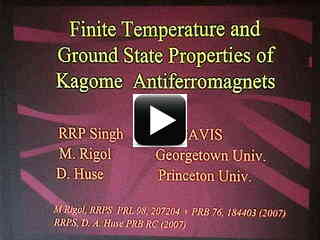We discuss finite temperature thermodynamic properties of kagome lattice antiferromagnets including Dzyaloshinkii-Moria (DM) anisotropies, exchange anisotropies, and dilution. The results are compared with measurements on recently synthesized material ZnCu$_3$(OH)$_6$Cl$_2$. While the higher temperature experimental data are well described by the Heisenberg model with J = 170 K, the low temperature data clearly deviate from the Heisenberg model and imply presence of DM interactions and impurities.
We also discuss a search for valence-bond crystal (VBC) ground states on the kagome
lattice using series expansion methods. Calculations lead to a selection of a VBC phase,
which consists of a honeycomb lattice of `perfect hexagons', with a ground state energy
per site of -0.433(1) J. Results for the dimerization order parameter will be discussed.
Extremely small energy differences between different VBC states suggest that this state
maybe very fragile to temperature and other perturbations. Preliminary results on the
triplet excitations in the system will be presented.
 Other video options
Other video options
To begin viewing slides, click on the first slide below. (Or, view as pdf.)
![[01]](tn/01.jpg)
![[02]](tn/02.jpg)
![[03]](tn/03.jpg)
![[04]](tn/04.jpg)
![[05]](tn/05.jpg)
![[06]](tn/06.jpg)
![[07]](tn/07.jpg)
![[08]](tn/08.jpg)
![[09]](tn/09.jpg)
![[10]](tn/10.jpg)
![[11]](tn/11.jpg)
![[12]](tn/12.jpg)
![[13]](tn/13.jpg)
![[14]](tn/14.jpg)
![[15]](tn/15.jpg)
![[16]](tn/16.jpg)
![[17]](tn/17.jpg)
![[18]](tn/18.jpg)
![[19]](tn/19.jpg)
![[20]](tn/20.jpg)
![[21]](tn/21.jpg)
![[22]](tn/22.jpg)
![[23]](tn/23.jpg)
![[24]](tn/24.jpg)
![[25]](tn/25.jpg)
![[26]](tn/26.jpg)
![[27]](tn/27.jpg)
![[28]](tn/28.jpg)
![[29]](tn/29.jpg)
![[30]](tn/30.jpg)
![[31]](tn/31.jpg)
![[32]](tn/32.jpg)
![[33]](tn/33.jpg)
![[34]](tn/34.jpg)
![[35]](tn/35.jpg)
![[36]](tn/36.jpg)
![[37]](tn/37.jpg)
![[38]](tn/38.jpg)
![[39]](tn/39.jpg)
![[40]](tn/40.jpg)
![[41]](tn/41.jpg)
![[42]](tn/42.jpg)